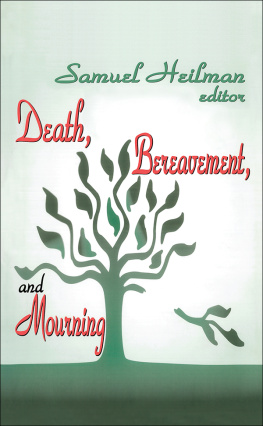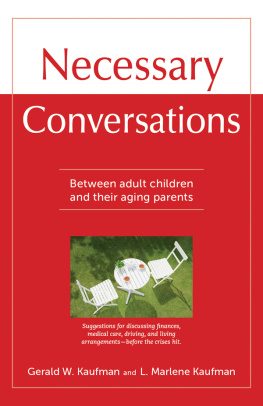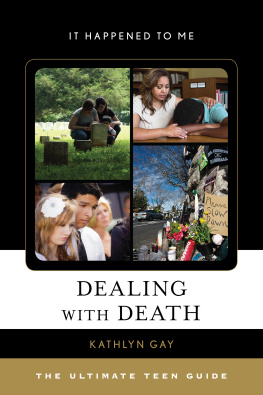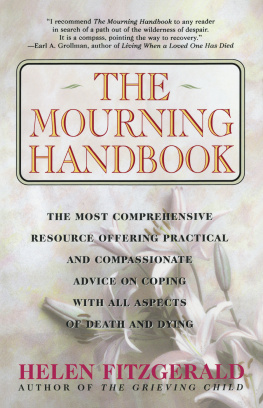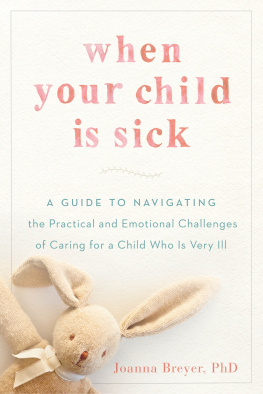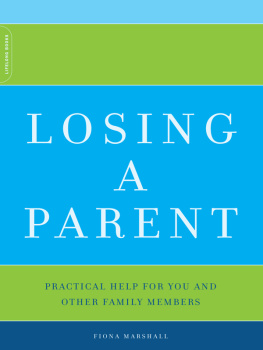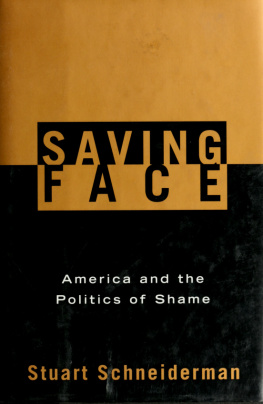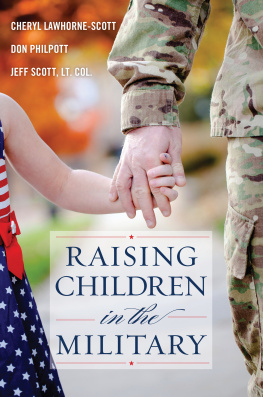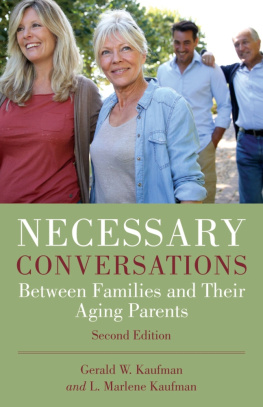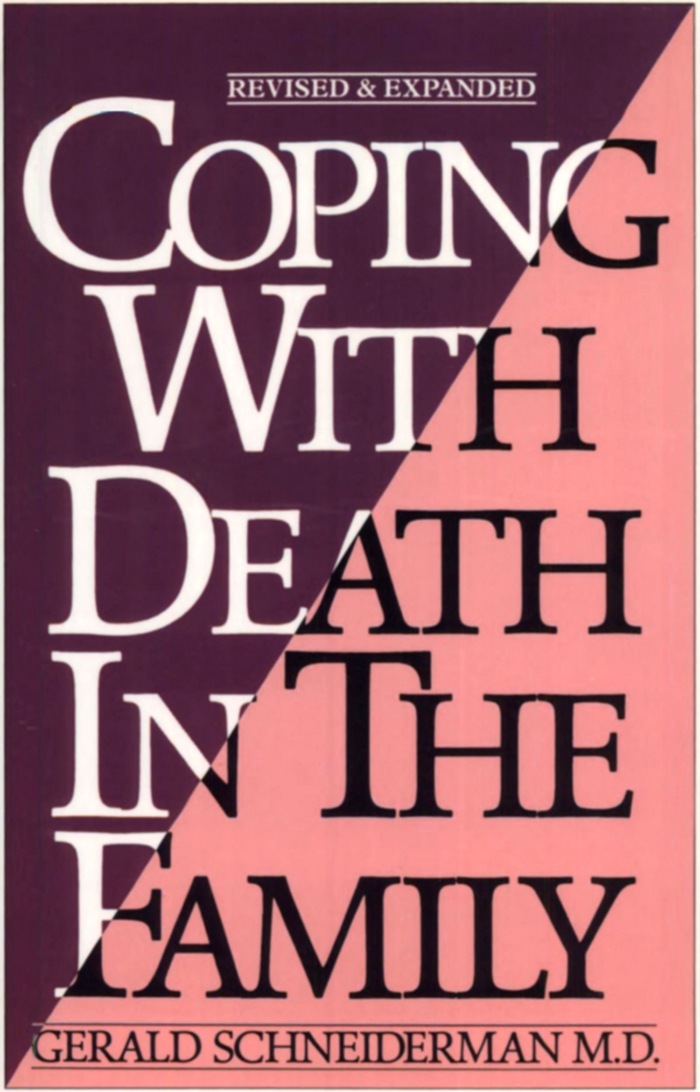COPING WITH DEATH IN THE FAMILY
TO RACHEL, JED AND LIZA
COPING
WITH
DEATH
IN
THE
FAMILY
GERALD SCHNEIDERMAN M.D.
NC Press Limited
Toronto 1994
Front Cover Design: Jerry Ginsberg
Back Cover Photo: Albert Gilbert
Fourth Edition 1994
Gerald Schneiderman, 1994
No part of this publication may be reproduced, stored in a retrieval system, or transmitted, in any form or by any means, electronic, mechanical, photocopying, recording or otherwise, without the prior written permission of NC Press Limited.
Canadian Cataloguing in Publication Data
Schneiderman, Gerald.
Coping with death in the family
Includes bibliographical references and index.
ISBN 1-055021-076-9
1. Death Psychological aspects. 2. Bereavement - Psychological aspects. I. Title. II. Series.
BF789.04536 1994 155.9'37 C94-930932-X
We would like to thank the Ontario Arts Council, the Ontario Publishing Centre, the Ontario Ministry of Culture, Tourism and Recreation, Toronto Hospital for Sick Children, the Canada Council and the Government of Canada, Department of Communications, for their assistance in the production of this book.
New Canada Publications, a division of NC Press Limited, Box 452, Station A, Toronto, Ontario, Canada, M5W 1H8.
Printed and bound in Canada
CONTENTS
All profits from the sale of this book, including authors royalties, are being donated to The Toronto Hospital for Sick Children.
ACKNOWLEDGMENT
The writing of this book evolved from my research on genetic disease in conjunction with the Departments of Biochemistry and Psychiatry at the Hospital for Sick Children. I would like to thank Dr. J. Alexander Lowden and Dr. Quentin Rae-Grant for assisting in the research which led to the writing of this book.
In addition, I am grateful for the support of many professional colleagues and friends during my writing. In particular, I would like to thank Dr. Graham Berman, the late Dr. John Cleghorn, Dr. Nathan Epstein and Mr. Justice Allan Goodman.
I am indebted to Dr. William Feldman, Dr. Susan Tallett and Patricia Winders, R.N. of the Department of General Pediatrics at the Hospital for Sick Children for their encouragement and enthusiasm in our research group.
I appreciate the interest of Caroline Walker of NC Press, who supported the fourth edition of the book and suggested the addition of a new chapter.
Gerald Schneiderman, M.D.
Toronto, Ontario
February 1994
INTRODUCTION
The only certainty in life is death. It is universal we are all affected by it during our lives, and we will all be its victim one day. Our reactions to death are as individual as our own lives but are at the same time, similar in many ways. This book is intended to help the bereaved understand some of their intense reactions, reassure them that other people have felt this way, and give practical advice on how to cope with the death and carry on with their own lives. There is also one chapter on dealing with your own death since watching our friends and family die, reminds us of our own mortality.
In my clinical practice I see the intense pain and suffering that death causes every day for the survivors. Adults may develop emotional problems or turn to drugs and alcohol in an attempt to ease the pain, and children may develop physical or behavioral problems because they cannot accept the death of a parent, brother or sister. These people are not suffering a mental disorder. Their ability to function has not been impaired because they have not recovered from the shock of death. This book is intended to help them and in some cases tell them where they can seek more help.
After the death of someone close, some people consult a psychiatrist because they may be suffering depression and may feel that life is no longer worth living. Working with the patients for weeks, months or years, psychiatrists help them overcome the paralyzing effect that death has had on their lives. However, most people deal with their grief alone and do not get professional help if they are having problems. It is hoped this book will show them that they are not alone and that all over the world people are experiencing the same fears and anxieties.
Even though we all come from varying ethnic backgrounds, practice different religions, and live in different communities, there is a certain universality to grief and mourning. This book does not deal with the various rituals practiced by different groups when death occurs nor the variations in mourning or funerals. It does deal with the emotions that all people, regardless of origin, experience when they lose someone close. We are basically all the same, and losing a father or a wife in North America will produce the same void in the survivors as it does in Africa.
This is a common sense guide for all age groups on how to live with the loss of a loved one. It does not provide magical cures for depression, nor can it eradicate loneliness, but it is hoped it can give the strength and reassurance necessary to cope with the difficulties of bereavement. An important message is that regardless of the pain and hurt, survivors have a responsibility to carry on and pursue life to its fullest. The living can also draw inspiration from the dead and strength from the experience of coping with death. The book also includes constructive suggestions for friends and family about how they can best help the survivors.
This book is intended primarily for the family. The stronger the unit, the better equipped it is to deal with problems, and the easier it will be for the surviving members to complete their mourning.
If the climate of the family has always been one in which the mother and father have been honest with each other and have worked at their marriage, chances are they have transmitted their openness and commitment to their children. If the children can come to their parents when difficulties arise and get assistance, they will feel secure enough to go to them in times of crisis. This becomes very important when a death occurs. In families where there is division and abuse among the members, a death may mark the end of the unit. If the parents and children are not prepared to support and help one another through a crisis, the family may just as well break apart, and in many cases it does.
Families who are committed to staying together must be realistic after a death and realize there are difficult times ahead. If it was a parent who died, the family must restructure and reallocate roles. A death in the family should not mean the end of the family. This book tries to offer hope to families and show that although death is tragic, life can and must go on for the survivors.
I
DEATH OF AN INFANT
A century ago, it was not unusual for a mother to experience the death of one or more of her children. Infant mortality rates were high, about one in six newborns died. Today, however, people are shocked to hear of infant deaths, and the mortality rate among newborns is about one in one hundred. Most people never experience nor expect to experience the death of an infant and as a result, such deaths seem doubly shocking. Despite the technological advances of modern medicine however, some babies still die, frequently as premature infants, although also from congenital malformations, asphyxiation, birth injuries, influenza, pneumonia and other infections.
During the first few months of life an infant is totally helpless in providing for itself and can communicate with its caregivers only by crying. Because it is too early for a babys eventual strengths and weaknesses to show themselves, parents tend to pin their hopes and aspirations, realistic and otherwise, on their baby. Parents can hope that a baby will excel academically or in athletics, music, or art; in fact, they can let their imaginations run wild simply because there is nothing at this stage to prove them wrong. The realities of course come later when the politician becomes a printer, the concert pianist turns tuner and the hockey star cannot skate. As children grow older and begin to communicate their own feelings about what they are and what they want to be, parental fantasies give way to harsh realities. Parents who lose a child of four or five know exactly what they are losing. On the other hand, when a baby dies the familys hopes and dreams have not been tested and the death always leaves the sadness of what might have been.


